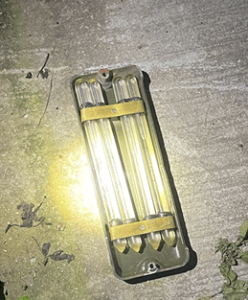Driving along a road in the small town of Lillian, Alabama, late one evening, a private individual heard a clatter as the antique safe he was transporting fell out of his truck. He pulled over to investigate and noticed some sort of device had fallen out of the safe when it hit the ground. It looked like a metallic clam shell with four glass ampoules of clear, yellowish liquid inside. Concerned (and rightly so), the owner called the local police department. Before long, the fire department and Baldwin County Emergency Management Agency (EMA) were looped into the investigation of this potentially hazardous curiosity. Baldwin County EMA temporarily evacuated the neighborhood as a precautionary measure. They then wrapped, packed, and over-packed the device and transported it to a secure out-building at their office in Robertsdale. Greg Stover, of PPM, was then brought in to assist in the investigation, since this peculiar device was a mystery to everyone involved.
 Greg put on his environmental sleuthing hat, and dove into some research. A little-known fact about environmental consultants is that research and investigation play a major role in what we do. We don’t often go into a situation with all the facts laid out for us – it’s up to us to figure out what’s going on in the environment and find solutions for how to remediate problems. As it turns out, this mystery device was a booby trap used by a company named Badger Safe Protector Company in the 1920s to deter safe crackers. The device was designed so that when the safe was opened improperly, it would fall, breaking the glass ampoules and releasing tear gas that would chase away or overcome the bad guy. The specific chemical used was called chloropicrin, which was used by the Germans in World War I in combination with phosgene or mustard gas in chemical warfare. Chloropicrin is a lung-damaging agent that can be inhaled, ingested, or absorbed through the skin. It is not as toxic as other chemical agents, but it induces violent vomiting. During the war, this would force opposing soldiers to remove their gas masks, exposing themselves to a lethal dose of phosgene or mustard gas. After the war, some guy got the bright idea that chloropicrin would be a great chemical to release in a confined room with a safe cracker. About 400 milliliters of this stuff released into the air as a gas would probably clear a decent-sized building!
Greg put on his environmental sleuthing hat, and dove into some research. A little-known fact about environmental consultants is that research and investigation play a major role in what we do. We don’t often go into a situation with all the facts laid out for us – it’s up to us to figure out what’s going on in the environment and find solutions for how to remediate problems. As it turns out, this mystery device was a booby trap used by a company named Badger Safe Protector Company in the 1920s to deter safe crackers. The device was designed so that when the safe was opened improperly, it would fall, breaking the glass ampoules and releasing tear gas that would chase away or overcome the bad guy. The specific chemical used was called chloropicrin, which was used by the Germans in World War I in combination with phosgene or mustard gas in chemical warfare. Chloropicrin is a lung-damaging agent that can be inhaled, ingested, or absorbed through the skin. It is not as toxic as other chemical agents, but it induces violent vomiting. During the war, this would force opposing soldiers to remove their gas masks, exposing themselves to a lethal dose of phosgene or mustard gas. After the war, some guy got the bright idea that chloropicrin would be a great chemical to release in a confined room with a safe cracker. About 400 milliliters of this stuff released into the air as a gas would probably clear a decent-sized building!
Some reports indicated Badger may have also used phosgene in the ampoules. Others claim that Badger just put that “fake news” out as hype to further scare safe crackers away. Even so, literature indicates that chloropicrin can degrade to phosgene under heat. How much heat? Unknown. But 100-year-old safes could be exposed to a lot of extreme environments. Consider sitting many summers in a garage in Lillian, Alabama. In other words, really bad stuff! The appearance of liquid chloropicrin and phosgene is essentially the same, no way to know until it’s too late. Phosgene accounted for 85,000 of the chemical warfare deaths in WWI.
The preferred method of disposal is by controlled demolition. In our case, the Alabama Bureau of Investigation (ABI) Bomb Squad in Mobile took the material and did just that. Somehow, the glass ampoules survived falling off a truck during this incident. But these things are 90-100 years old and could be brittle and ready to break with just a wiggle. They might fall and shatter, even if the safe is opened properly. They could even crack with a light touch or sudden temperature change.
So, if you stumble across an old safe in your grandparents’ attic, give PPM a call. We’ve got the sleuthing skills that can help you determine what you’re dealing with and avoid potential exposure to some hazardous materials that you don’t want to mess with!
 Contributed by Greg Stover, Senior Project Geologist, PPM Consultants
Contributed by Greg Stover, Senior Project Geologist, PPM Consultants

